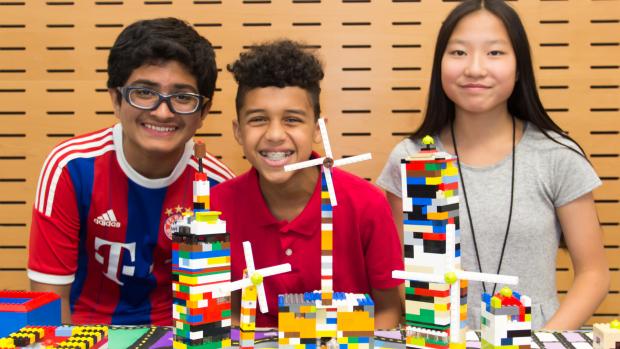The Cities of the Future – and the Young People Envisioning Them

The fact that they were built largely with brightly colored Lego bricks did not detract from the fact that on display were carefully designed, meticulously planned and technologically advanced model cities.
The occasion was the Science of Smart Cities (SoSC) Expo, the culmination of a month-long program at the NYU Tandon School of Engineering’s Center for K12 STEM Education. Middle school students participating in SoSC had spent July learning about energy, infrastructure, transportation, and wireless communications – all facets of engineering, science and technology fields that contribute to making urban areas more livable and sustainable. With a jam-packed schedule that included field trips, guest lectures, and hands-on projects, they learned how to use microcontrollers to program traffic lights, built wind turbines, and designed battery-powered smart cars. Now, several rooms in Rogers Hall had been set up to showcase everything they had learned.

Candice Phillips Roy, Kaitlyn Yang, Hiuansh Dhakne, and Justin Deng, who hailed from various middle schools throughout the city, had teamed up during the program to design an island city. “It makes a lot of sense,” they explained, “because of the abundance of natural energy sources, like wind for the wind turbines we built, sun for the solar panels, and water for the tidal generator.” (If it seemed unusual to find middle-schoolers who knew all about tidal generators, it seemed even more unusual that they could explain the topic with such confidence and poise – the result of presentation training SoSC participants received from members of the Irondale Ensemble Project, a local theater group that works with the Center to incorporate public speaking skills learned through theater techniques, and the arts, into the STEM curriculum.)
Seemingly no aspect of city planning escaped the notice of the various teams. Their models featured charging stations for electric cars, plenty of green space, carefully placed fire and police departments, smart airports, conveniently located schools, and more.
Asked what they felt the best part of the program had been, students gave answers ranging from “the chance to work with Arduino circuit boards” to “realizing that helping plan smart cities can be a good career.”
One aspiring engineer gave a response that speaks directly to the importance of the work being done by the Center for K12 STEM Education: “Being here this summer taught me that there are a lot of other kids my age seriously interested in science, engineering, and technology,” he said. “That’s not something I see every day at my school during the year.”




